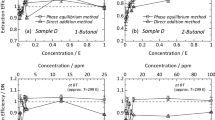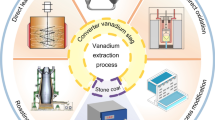Abstract
In electric-arc furnace dust, zinc content can reach 43%, lead and content can reach 4%. The ecotoxicant content such as dioxins and furans (D&F) adsorbed on dust particles achieve 500 ng/kg of dust. Generally, zinc and lead are reduced from their oxides by dint of carbon (an average of 500 kg/t dust). The results of thermodynamic calculations and experimental studies have shown that these metals can be extracted from dust without the participation of carbon or at its low content (less than 3%) [1]. Temperature of about 1400 K is required to extract lead, and about 2000 K is required for zinc extraction. The temperatures of their extraction depend on the dust composition, in particular, on the carbon content, chlorine and the O/C ratio [2]. They can also depend on phase and dispersed dust composition. A physicochemical analysis of the dust formation processes in electric arc furnaces (EAF) has been carried out, the composition and properties of dust have been investigated, and experimental studies of the zinc and lead selective extraction process in laboratory conditions have been leaded. A dust processing technology has been developed and the possible innovative potential of the expected results has been assessed. The approaches are based on the study of a continuous two-stage process of carbon-free and zinc and lead selective extraction from EAF dust of different composition. One of the main results of the work, along with the creation of a technology that ensures the selective zinc and lead extraction up to 99%, is the development of a process for neutralizing EAF dust from D&F to an environmentally safe level.



Similar content being viewed by others
REFERENCES
Patrushov, A.E., Technical and economic efficiency evaluation of pyrometallurgical technology for EAF dust processing, Vestn. Irkutsk. Gos. Tekh. Univ., 2020, vol. 24, no. 3, pp. 672–683.
Adedoyin, F.F., Gumede, M.I., Bekun, F.V., et al., Modeling coal rent, economic growth and CO2 emissions: Does regulatory quality matter in BRICS economies? Sci. Total Environ., 2020, vol. 710, art. ID 136284.
Rabinovich, V.A. and Khavin, Z.Ya., Kratkii khimicheskii spravochnik (A Brief Chemical Handbook), Rabinovich, V.A., Ed., Leningrad: Khimiya, 1977.
Porzio, G.F., Colla, V., Fornai, B, et al., Process integration analysis and some economic-environmental implications for an innovative environmentally friendly recovery and pre-treatment of steel scrap, Appl. Energy, 2016, vol. 161, pp. 656–672.
Simonyan, L.M. and Alpatova, A.A., Prediction of zinc and lead behavior during steel electric smelting, Metallurgist, 2016, vol. 60, nos. 7–8, pp. 676–678.
Simonyan, L.M. and Demidova, N.V., Origins and behavior of dioxins and furans in zinc-bearing dust, Steel Transl., 2019, vol. 49, no. 7, pp. 454–459.
Simonyan, L.M. and Demidova, N.V., Study of the behavior of dioxins and furans in the zinc and lead removal process from EAF dust, Steel Transl., 2019, vol. 49, no. 11, pp. 727–731.
Elanskii, G.N. and Medvedev, M.N., Dioxins as ecological hazard, Stal’, 2000, no. 2, pp. 82–86.
Karachentsova, A.N. and Ponomarev, A.Ya., Problematic issues of environmental safety during organochlorine pesticides disposal, Modeli, Sist., Seti Ekon., Tekh., Prirode O-ve, 2014, no. 4, pp. 208–213.
Ivanov, A.I., Lyandres, M.B., and Prokof’ev, O.V., Proizvodstvo magniya (Magnesium Production), Moscow: Metallurgiya, 1979.
Stewart, D.J.C. and Barron, A.R., Pyrometallurgical removal of zinc from basic oxygen steelmaking dust—A review of best available technology, Resour., Conserv. Recycling, 2020, vol. 157, art. ID 104746.
Halli, P., Agarwal, V., Partinen, J, et al., Recovery of Pb and Zn from a citrate leach liquor of a roasted EAF dust using precipitation and solvent extraction, Sep. Purif. Technol., 2020, vol. 236, art. ID 116264.
Siame, M.C., Kaoma, J., Hlabangana, N, et al., An attainable region approach for the recovery of iron and zinc from electric arc furnace dust, S. Afr. J. Chem. Eng., 2019, vol. 27, pp. 35–42.
Lin, X., Peng, Z., Yan, J., et al., Pyrometallurgical recycling of electric arc furnace dust, J. Clean. Prod., 2017, vol. 149, pp. 1079–1100.
Hazaveh, P.K., Karimi, S., Rashchi, F., et al., Purification of the leaching solution of recycling zinc from the hazardous electric arc furnace dust through an as-bearing jarosites, Ecotoxicol. Environ. Saf., 2020, vol. 202, art. ID 110893.
Lanzerstorfer, C., Electric arc furnace (EAF) dust: application of air classification for improved zinc enrichment in in-plant recycling, J. Clean. Prod., 2018, vol. 174, pp. 1–6.
Al-Harahsheh, M., Al-Nu’airat, J., Al-Otoom, A., et al., Treatments of electric arc furnace dust and halogenated plastic wastes: a review, J. Environ. Chem. Eng., 2019, vol. 7, no. 1, art. ID 102856.
Omran, M. and Fabritius, T., Effect of steelmaking dust characteristics on suitable recycling process determining: ferrochrome converter (CRC) and electric arc furnace (EAF) dusts, Powder Technol., 2017, vol. 308, pp. 47–60.
Simonyan, L.M., Shkurko, E.F., and Alpatova, A.A., RF Patent 2 623 509, Byull. Izobret., 2017, no. 33.
Simonyan, L.M. and Demidova, N.V., RF Patent 2710250, Byull. Izobret., 2019, no. 33.
Bruckard, W.J., Davey, K.J., Rodopoulos, T., Woodcock, J.T., and Italiano, J., Water leaching and magnetic separation for decreasing the chloride level and upgrading the zinc content of EAF steelmaking baghouse dusts, Int. J. Miner. Process., 2005, vol. 75, pp. 1–20.
Chen, W.-S., Shen, Y.-H., Tsai, M.-S., and Chang, F.-C., Removal of chloride from electric arc furnace dust, J. Hazard. Mater., 2011, vol. 190, pp. 639–644.
Trusov, B.G., TERRA software system for modeling phase and chemical equilibria, Materialy XIV Mezhdunarodnoi konferentsii po khimicheskoi termodinamike, Tezisy dokladov (Proc. XIV Int. Conf. on Chemical Thermodynamics, Abstracts of Papers), St. Petersburg: Nauchno-Issled. Inst. Khim., S.-Peterb. Gos. Univ., 2002, p. 483.
Marchenko, N.V., Metallurgy of heavy nonferrous metals. https://c-metal.ru/image/catalog/books/Marchenko.pdf. Accessed July 4, 2020.
Demidova, N.V., Study of the behavior of zinc, lead, dioxins and furans during heat treatment of metallurgical dust, MSc Thesis, Moscow: Moscow State Inst. Steel Alloys, 2019.
GN 2.1.7.3298-15. Approximate permissible concentrations (APC) of polychlorinated dibenzo-n-dioxins and dibenzofurans (in terms of 2,3,7,8-tetrachlorodibenzo-para-dioxin and its analogs) in the soil of populated areas, agricultural land and industrial sites. http://docs.cntd.ru/document/420306463. Accessed June 4, 2020.
Rykalin, N.N., Nikolaev, A.V., and Goronkov, O.A., Calculation of current density in anode arc spot, Teplofiz. Vys. Temp., 1971, vol. 9, no. 5, pp. 981–985.
Keglevich de Buzin, P.J.W., Heck, N.C., and Vilela, A.C.F., EAF dust: An overview on the influences of physical, chemical and mineral features in its recycling and waste incorporation routes, J. Mater. Res. Technol., 2016, vol. 4, pp. 194–202.
Antunes, P., Viana, P., Vinhas, T., et al., Emission profiles of polychlorinated dibenzodioxins, polychlorinated dibenzofurans (PCDD/Fs), dioxin-like PCBs and hexachlorobenzene (HCB) from secondary metallurgy industries in Portugal, Chemosphere, 2012, vol. 88, pp. 1332–1339.
Davy, C.W., Legislation with respect to dioxins in the workplace, Environ. Int., 2004, vol. 30, pp. 219–233.
Funding
This work was supported by the Fund for the Promotion of Innovations within the framework of the UMNIK program, contract No. 12 699GU/2017.
Author information
Authors and Affiliations
Corresponding authors
Additional information
Translated by Sh. Galyaltdinov
About this article
Cite this article
Simonyan, L.M., Demidova, N.V. Carbon-Free Selective Extraction of Zinc and Lead from EAF-Dust. Steel Transl. 50, 531–536 (2020). https://doi.org/10.3103/S0967091220080112
Received:
Revised:
Accepted:
Published:
Issue Date:
DOI: https://doi.org/10.3103/S0967091220080112




